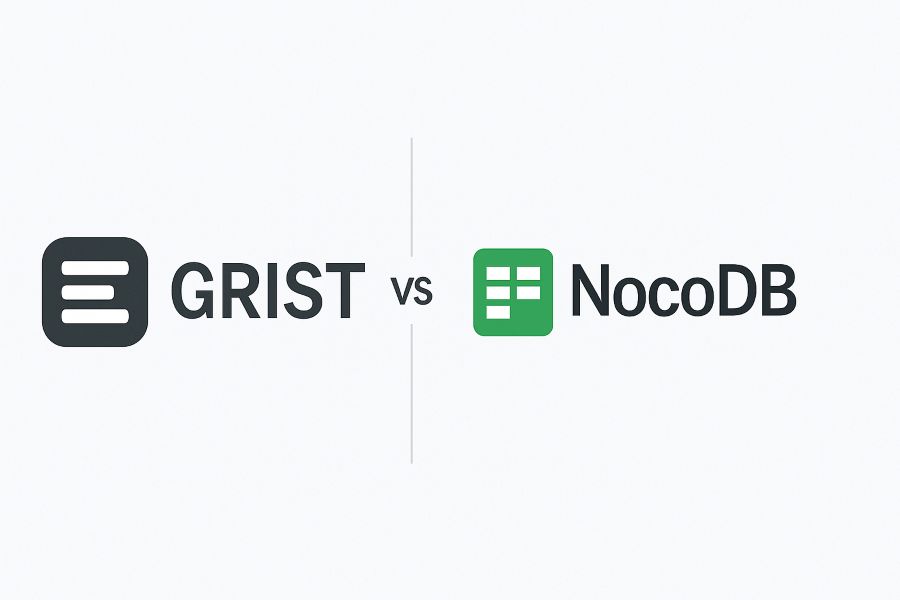Grist vs NocoDB: Choosing the Right Tool for Your Use Case
When managing data in a collaborative environment, the choice of tool can significantly affect productivity and maintainability. Two standout open-source options are Grist and NocoDB, but they’re built with very different philosophies in mind. This post breaks down where each tool excels — and where it might fall short — depending on how you work.
User Interface: The Edge Goes to NocoDB
If you’re coming from Airtable, you’ll likely feel more at home in NocoDB. Its polished, modern interface supports multiple view types like grid, gallery, kanban, and form — all of which are visually appealing and smooth to use.
Grist, on the other hand, feels more like a spreadsheet or a technical dashboard. It offers power-user features like custom widgets and formulas, but can feel a bit raw or utilitarian in comparison.
Verdict: If visual polish and day-to-day usability are your top priorities, NocoDB’s UI is more inviting.
API and Automation: Grist Pulls Ahead
Automation is where Grist really shines. It supports a native upsert API out of the box — something NocoDB lacks. This makes workflows like syncing external data or integrating with tools like n8n much simpler.
With Grist, you can perform an upsert by including a require field in the payload — this specifies which fields must match for an update to occur. If no record matches, Grist inserts a new one. This allows you to implement flexible upserts without fetching records first. In contrast, NocoDB lacks native upsert support, requiring a two-step process: manually check if a record exists (via a GET), then decide to PATCH or POST.
Verdict: For developers and automation-heavy workflows, Grist is more capable and efficient.
Access Control: No Contest
Grist’s Access Rules system is one of the most advanced in the no-code world. You can define row-level and field-level permissions using expressions like:
user.Email == record.Owner
You can even simulate how the app behaves for a specific user, helping you test permission boundaries. NocoDB’s access control, by contrast, is limited to basic project-level roles with no row- or field-level logic.
Verdict: If your use case involves sensitive data or multi-role collaboration, Grist offers the flexibility you need.
Performance and Scalability
If you’re working with thousands of rows, both tools can handle them reasonably well, but performance may vary depending on usage patterns. NocoDB’s UI is generally more responsive for basic grid navigation and editing, especially without complex formulas. Grist, on the other hand, may experience slowdowns in the UI when dealing with heavy computed columns, inter-table formulas, or complex access rules, though its API remains reliable even with large datasets.
Verdict: NocoDB generally feels more responsive for basic CRUD operations in the UI, while Grist is better suited for programmable datasets where automation, formulas, and access rules are more important than raw interface speed.
TL;DR: Which Should You Choose?
| Feature | NocoDB | Grist |
|---|---|---|
| UI polish | ✅ Modern and sleek | ➖ Spreadsheet-style |
| Views (Kanban, Form, etc.) | ✅ | ➖ Limited |
| Upsert support | ❌ Manual workaround | ✅ Native API |
| Row/field permissions | ❌ Basic only | ✅ Advanced ACL |
| Automation friendliness | ➖ Requires logic in client | ✅ Built-in flexibility |
| Developer experience | ➖ Simpler, but limited | ✅ More powerful for APIs |
| Best for | Airtable-like UI, casual data teams | Complex automation, secure collaboration |
Final Thoughts
If you’re looking for an Airtable replacement with a smooth UI for your team to work in daily, NocoDB is a great choice. But if you need serious automation, fine-grained permissions, or API-driven workflows, Grist is the tool that delivers — even if it looks a little less shiny.
Both projects are open-source and actively developed, so the line between them may continue to blur. For now, choose the one that aligns best with your current pain points.
